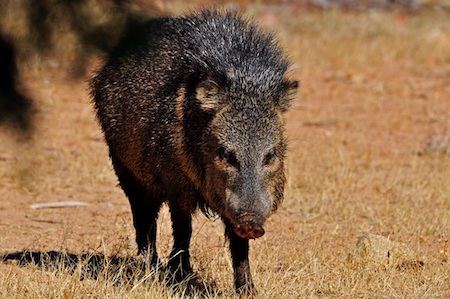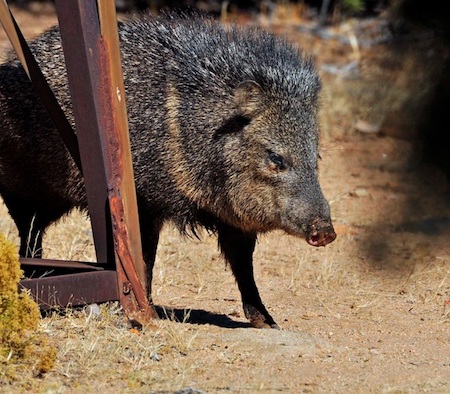The Chronicles Of Grant County
 A javelina in the area of the Burro Mountains in Grant County. (The photograph was provided courtesy of Steve Douglas, November 17, 2011.)
A javelina in the area of the Burro Mountains in Grant County. (The photograph was provided courtesy of Steve Douglas, November 17, 2011.)
One of the animals that you might find roaming Grant County is a javelina. You might smell one before you actually see a javelina. The National Park Service indicated that javelinas are native to America’s Southwest.
“The collared peccary (Tayassu tajacu), commonly known as the javelina, is found as far south as Argentina and as far north as Texas, New Mexico, and Arizona,” according to a statement updated by the National Park Service on July 5, 2020. “Collared peccaries are in the even-toed, hoofed mammal order of Artiodactyla. Javelina are mistaken for pigs, but they are in a different family than pigs.”
Among the differences cited by the National Park Service in that statement are that javelinas have “three toes on the hind foot, bones are fused in the foot, ulna and radius ‘lower arm bones’ are fused, 38 teeth, canine teeth are straight, have scent glands, have complex stomach, lack a gall bladder, have a short tail, [and] lack sweat glands.”
Pigs, though, have “four toes on the hind foot, bones in the foot are not fused, ulna and radius are not fused, 34 or 44 teeth, canine teeth are curved, lack scent glands, have a simple stomach, gall bladder is present, have a long tail, [and] have sweat glands,” according to that statement from the National Park Service.
(Please note that the plural of javelina is both “javelina” and “javelinas.” The quotes from the National Park Service use both forms. This news column, though, uses “javelinas” for the plural format.)
“Javelina thrive in a variety of habitats and are able to easily adapt to different areas within their territory,” noted that statement from the National Park Service. “Javelina are herbivores (plant eaters) and frugivores (fruit eaters). They eat a wide variety of fruits, tubers, rhizomes, bulbs, acorns, grass, green shoots of annuals, stems of prickly pears, lupines, mesquite beans, and lechuguilla. They are also opportunistic and will eat animal matter when it is easily available, or might accidentally ingest it while foraging for other food. Succulent prickly pear pads make it possible for javelinas to survive until rainfall provides additional new annual food plants and water sources. Javelinas drink water when it can be found, but it is not essential if succulents are available.”
“Javelina feed by spreading out in a loosely knit group,” that statement from the National Park Service continued. “As they day heats up, they seek shelter in cooler canyons, caves, and areas of dense shrub. They will feed again in late afternoon until dark. Feeding time increases in cooler months and resting time increases in the summer. Javelina may even feed at night during the hottest months. After feeding, the band will bed down under rocky overhangs, in caves, and in shallow depressions with heavy brush cover. They will huddle together in a group for warmth and protection…On average, javelina live 7 years in the wild. Javelina live in groups (or bands), but do not form long-term pair bonds. Band size ranges from five to twenty-seven animals.”
Life can be tough for young javelinas living in the wild.
That statement from the National Park Service indicated that “there is typically a 50% or higher mortality rate for the young. Coyotes, bobcats, black bears, and mountain lions prey on javelinas.”
On that issue of smell, “…the javelina releases a very strong odor when alarmed or excited,” noted a statement from the National Park Service updated on April 30, 2021. “Scent glands are present below each eye and on the Javelina's back. These glands are also used to mark territory, which can range from 75 to 700 acres. Javelinas will also mark each other with these scent glands by rubbing against one another. Due to extremely poor vision, the javelina must rely on these scents and their sense of smell to communicate. The smell can be quite strong, and you will usually smell a javelina before you see it.”
 A javelina roaming in the area south of Silver City in the Burro Mountains. (The photograph was provided courtesy of Steve Douglas, November 17, 2011.)
A javelina roaming in the area south of Silver City in the Burro Mountains. (The photograph was provided courtesy of Steve Douglas, November 17, 2011.)
Do you have questions about communities in Grant County?
A street name? A building?
Your questions may be used in a future news column.
Contact Richard McDonough at chroniclesofgrantcounty@mail.com.
If your email does not go through, please contact editor@grantcountybeat.com.
© 2022 Richard McDonough


